Either Or is the latest concert program from the long-running Soundstream Collective, helmed by Adelaide-based composer and pianist Gabriella Smart. On this occasion, the Elder Conservatorium’s Elder Hall hosted a diverse program of solo and small ensemble works for traditional instrumentation and electronics, taking as its unifying (albeit loose and thoroughly abstracted) theme the construction of language.
Disappointingly, Irish composer Gerald Barry’s one-act opera for soprano and piano, La Plus Forte, based on Strindberg’s short play The Stronger, could not be performed, soprano Allison Bell having fallen victim to the vagaries of Adelaide’s weather. If the revised program felt at times insubstantial without the opera’s inclusion, additional works by Erkki Veltheim, Elena Kats Chernin and Alvin Curran nevertheless proved canny substitutions.
The evening’s first bracket opened with Cat Hope’s Stella Degradation for viola and cello. Taking its inspiration from Xenakis’ Terretektorh (1955-56) and a version of its accompanying score, the work emphasised glissandi, drone and noise, quiet passages of lightly bowed glissando giving way to abrupt bursts of dissonance. Reading graphic notation on iPads and bathed in crepuscular blue light, performers Erkki Veltheim (viola) and Ewen Bramble (cello) performed with considerable control and virtuosity.
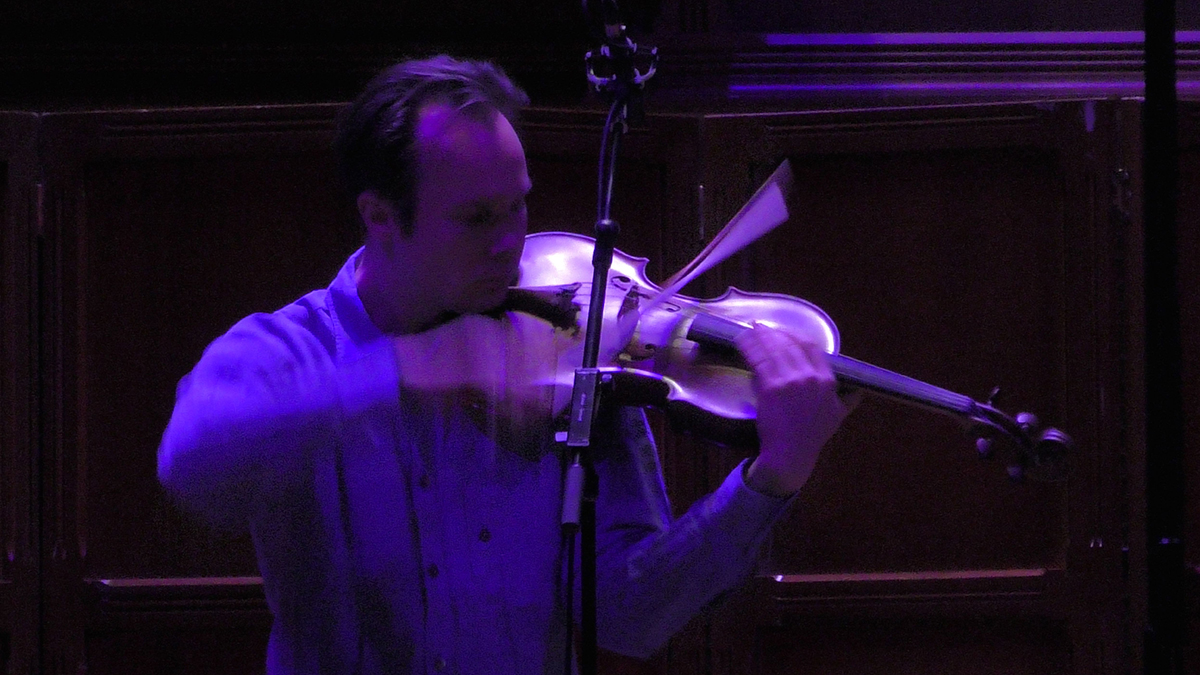
Erkki Veltheim, photo courtesy Soundstream New Music
An over-reliance on the upper registers of the instruments, however, proved irksome, preventing the harmonic characteristics of the lower registers — an important compositional interest of Hope’s, as displayed in the recent work-in-development showing of her new opera Speechless at Vitalstatistix in Adelaide — from being sufficiently explored.
With a structure skillfully and affectingly built over its six-minute duration, Leah Blankendaal’s composition, titled We were met by ordinary devotion, was a concert highlight, with its exceptional marriage of clarinet and electronics. Mitch Berick’s richly tonal high solo clarinet, recalling Messiaen’s birdsong transpositions, contained a distinctive recurring motif that, sampled live and relayed with modulated treatments, fractured and complexified, Blankendaal’s lightly abrasive sonic layering gradually giving way to low rumbles as the work concluded.
The use of austere lighting enhanced the performance’s overall effect, Berick illuminated by a single spot centrestage, Blankendaal stage right, lit solely by the glow of her laptop. A Soundstream Emerging Composers Forum commission, We were met with ordinary devotion perfectly demonstrated Blankendaal’s considered choice of instrumentation and treatments while intriguingly exploring ideas of pregnancy, female autonomy and body ownership (the title is taken from Maggie Nelson’s memoir The Argonauts) through the morphing, growing form of the work.
The first bracket of the program concluded with Errki Veltheim’s The Continuity Hypothesis, an ambient ensemble work for electronics, woodwinds, electric keyboard and cello, underscored by what Veltheim described in his introduction as a “machine soundscape” (think of those ominous, industrial chugs and drones that bookend Pink Floyd’s “Welcome to the Machine”).
As well, Veltheim nodded to absurdist theatre and language acquisition theory, warning the audience to expect “not a piece of music but a listening experience.” In his program notes, he states that the work involves each performer being given a “vocabulary of short musical gestures that mimic the phonemes observed in infantile babbling, adapted for each instrument through specific techniques such as slap-tongues for the bass clarinet, muted pizzicato for the cello and sampled sounds on the keyboard.”
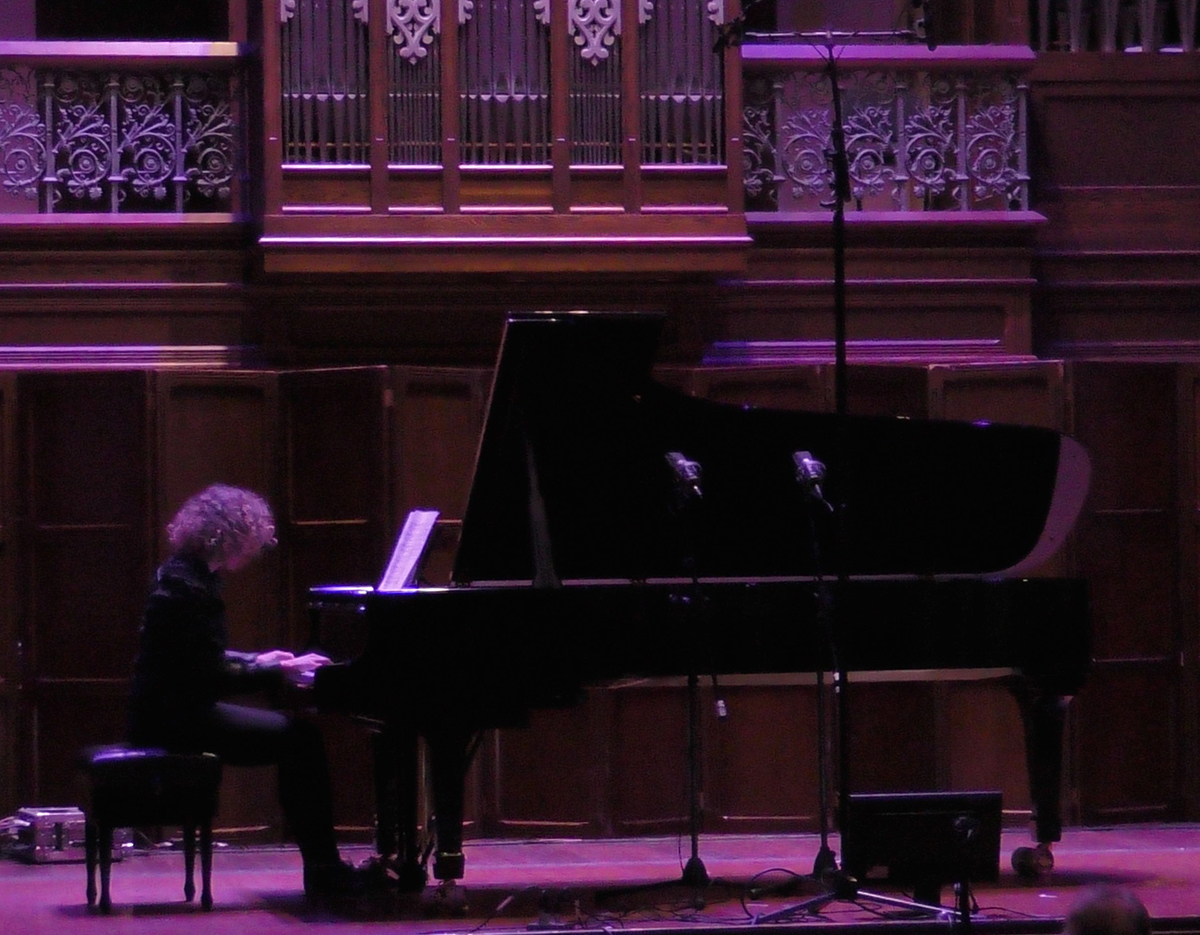
Gabriella Smart, photo courtesy Soundstream New Music
However, the work’s near-half hour duration and unvaryingly languid pace challenge without reward, becoming an exercise in audience endurance rather than a dynamic expression of the composer’s interest in “the relationship of (language) processes to the semiotics of musical composition and performance” (program).
Veltheim returned to the stage following the interval to perform his Turing Test for improvised viola and electronics. Following a similar compositional approach to that of Cat Hope’s work, the first half of Turing Test — named for Alan Turing’s famous experiment designed to gauge the ability of a machine to think like a human — was characterised by dissonant glissandi, occupying the entire range of Veltheim’s viola.
The electronic accompaniment arrived abruptly a couple of minutes in, somewhat unsubtly relaying captures of the viola across stereo delay with granulated textures and pointillist tones. With Veltheim’s bow visibly shredded, the second half offered some reprieve with an exploration of drone and an emphasis on the harmonic qualities of the viola’s tone, which nicely melded with the electronic treatments.
Two works for solo piano concluded the program — Elena Kats Chernin’s Piano Memories (1st movement) and Alvin Curran’s For Cornelius — equally impeccably performed by Gabriella Smart. Both offered a welcome contrast to the erratic atonalities of Veltheim’s works, accentuating complex yet frequently spacious tonalities, and strongly reminiscent of Erik Satie’s Gymnopédies and Ryuichi Sakamoto’s works for piano. Kats Chernin’s Piano Memories — inspired by the ‘silence’ of the now-retired piano at the old Alice Springs Telegraph Station — came across as the lighter of the two works, with phrasings tending to drift solemnly before gently slipping away.
Curran’s For Cornelius — dedicated to the memory of English experimental composer Cornelius Cardew — developed along similar lines, its comparably pensive mood underscored by subtle dissonances that made for an uneasy, funereal first half. Contrastingly, the second half saw an abrupt shift to pounded open chords, cascading aggressively with sustain but impressively controlled by Smart.
Given La Plus Forte’s regrettable omission from the second half of Either Or’s program, Gabriella Smart and company must be commended for curating a replacement suite of works at such late notice that complemented the rest of the program in terms of relative tone and consistency. Of the newer works presented, Blankendaal’s beautifully realised We were met by ordinary devotion was the most successful, the other works demanding greater expression, depth and momentum to realise their full potential.
–
Soundstream Collective, Either Or; Elder Hall, Adelaide, 9 Aug
Tristan Louth-Robins is a sound artist based in Adelaide. Writer and playwright Ben Brooker is RealTime’s Adelaide reviewer for contemporary performance, theatre and dance.
Top image credit: Mitch Berick, photo courtesy Soundstream New Music
Few operas are written in Australia and even fewer are publicly workshopped as part of the development process. Cat Hope, Professor of Music at Monash University, and Head of the Sir Zelman Cowen School of Music, is developing a major new operatic work, titled Speechless. The audience response to the opera’s first outing over two nights as part of Adelaide’s Vitalstatistix incubation program was overwhelmingly positive.
Hope describes Speechless as “an experimental noise opera — in three acts, for four soloists, the Australian Bass Orchestra and choir.” Distressed at the inadequacy of the response to Gillian Triggs’ 2014 Human Rights Commission report, The Forgotten Children: National Inquiry into Children in Immigration Detention, Hope based the graphic score and thematic material for Speechless on elements of the report.
This intense and dramatic work of roughly an hour’s duration involves four outstanding soloists — Alice Hui-Sheng Chang, Kusum Normoyle, Judith Dodsworth and Sage Pbbbt — with two Adelaide community choirs, Hoi Polloi and Born on Monday, and the Australian Bass Orchestra (formed by Hope in 2014) playing cellos, double basses, bass guitars, bass brass (trombones, tuba and euphonium), bass drums, electronics (including a theremin), and a harp, all held together by conductor Aaron Wyatt. While the orchestra all play below middle C, the choir and soloists extend into the upper registers, creating a dialogue across the treble and bass staves that suggests children being tossed around on stormy seas. In other contexts, this might be considered experimental music, that is, music intended to explore sonic or instrumental possibilities. Importantly, there is no dialogue in the opera. The extensive range of vocal sounds, from hissing and muttering to screaming, do not convey speech, reflecting the opera’s title. Hope’s intention is to convey the silencing of protests against detention, and the opera is thus both a personal statement and a highly successful musical innovation.
I spoke with Cat Hope about the workshop performances of Speechless.
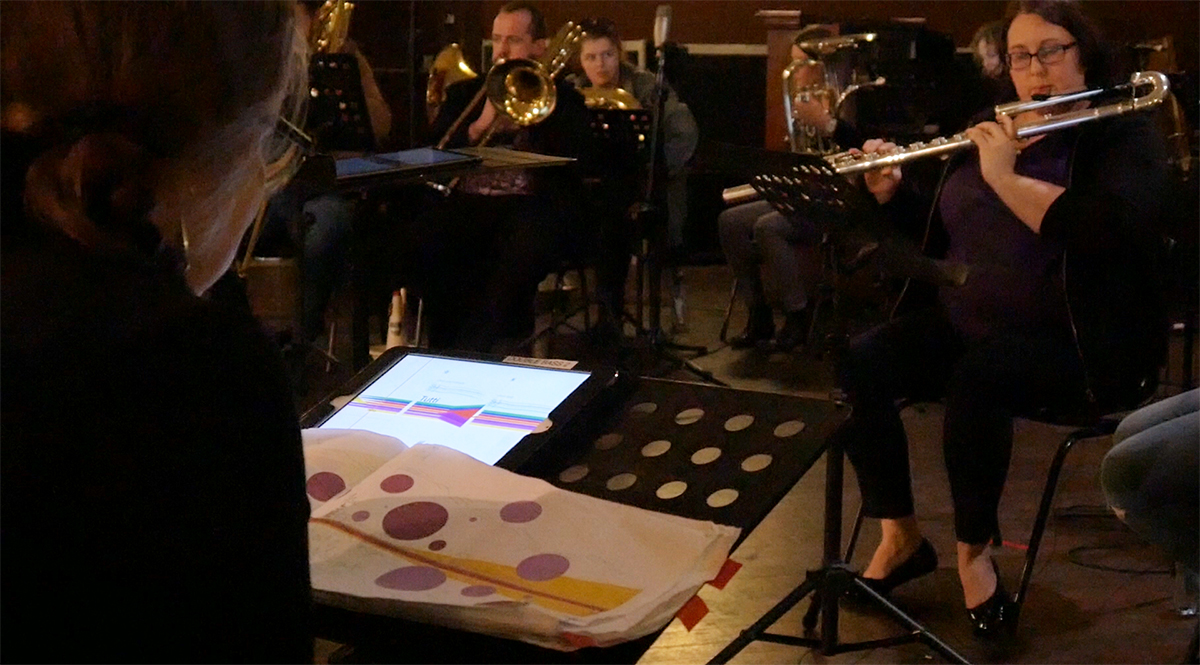
Cat Hope and score for Speechless workshop, photo courtesy Tura New Music
Your program note makes clear how the situation of children in detention has inspired the opera, but that you did not want to be didactic. The resulting work is emotionally intense without being so. How well do you think it worked in expressing your concerns?
The opera is about my concern for people who have been rendered speechless by decisions made by the Australian government: refugees, children (as refugees from domestic violence) and Indigenous communities. I was aware that any attempt to communicate this was a big risk — how to make a work on a very specialised topic without any narrative, words or action, and not be programmatic? Are the tools of my music enough? And, is the intent communicated or is it all too abstract? I think that once the context is provided (through the program note, for example) people find their own connections, their own narratives and meanings. It can be different for each listener, no one is being told how to feel or react. The work is driven by my response to important issues of our time. The singers need to find meaning in it for themselves. I think we succeeded in that performers and audience alike found that meaning.
Speechless is a large-scale work that combines a unique ensemble — a bass orchestra — with community choirs, soloists using extended vocal techniques and graphic scores. It already seems highly resolved, but having seen it in performance, how do you now feel about it musically?
I came to the workshop process with 50 of the 55 minutes we presented written, then added a new interlude, and made some significant changes once I got there. I had engaged many operatic devices and plotted the structure out quite carefully. But I have worked with the Australian Bass Orchestra, and low frequency instruments more generally; I knew more or less what to expect. I chose my collaborators carefully, and made sure that there were people leading sections who know my music, who understood it and, when required, could bring their own style to the piece. It was a very moving moment, one that I will never forget. There are still some changes I would like to make that will take longer than we had between rehearsals.
What was the impetus for the creation of the Australian Bass Orchestra and why did you incorporate a pre-existing musical concept into Speechless?
I formed it to perform low frequency music that was not driven by any style or instrument plan and could be formed in any place with any players of any instrument with a bass range. It is a sporadic project that only occurs when an opportunity arises. I thought a lot about how to handle the complex topic of the opera, and realised the concept of the bass orchestra would suit. As with the engagement of the community choir, it was important to me that the work speaks from, as well as in, the place it is performed. Local performers bring that. Given how important it was for me to not speak on behalf of anyone, it seemed the right place for an orchestra like this to be engaged.
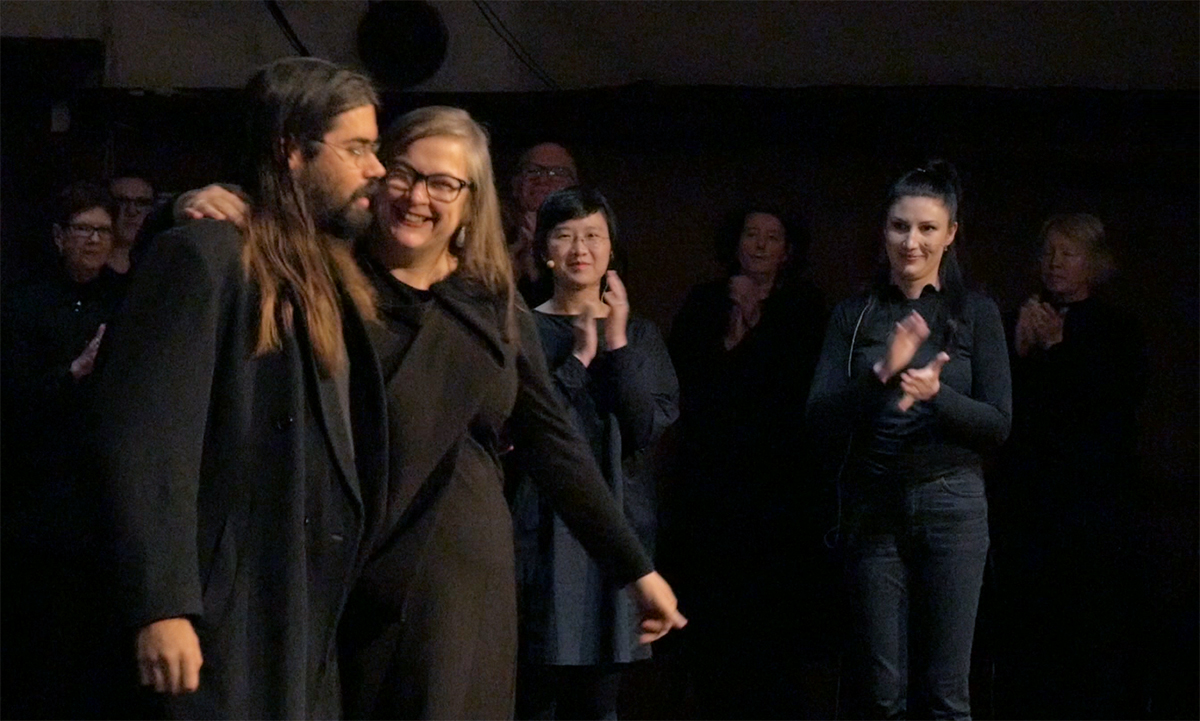
Cat Hope with conductor Aaron Wyatt and soloists Alice Hui-Sheng Chang and Kusum Normoyle, Speechless Workshop, photo courtesy Tura New Music
Were the soloists selected to introduce their individual vocal techniques into the overall composition? Is there flexibility in the score to enable performance with other soloists?
It was important that the singers each came with their own style, and their parts reflect different qualities they bring — not them personally, rather their approach to music. The soloists coming from an improvisatory practice have more freedom; Kusum Normoyle has her own “scream” part, while the operatic soloist, Judith Dodsworth, has a poignant “aria” moment. I have thought a lot about what makes this work an opera, and how opera reflects issues and music of the day. Music of the day is a varied and complex thing: pop music, improvisation, classical, jazz, sound art and so on… So I chose the four singers from this pool of contemporary practice, and my score enables them to interpret it from within their own realm of experience.
You have considerable experience in the use and development of graphic scores. Are they effective in encouraging the performers to extend themselves and to be active interpreters of the material?
Graphic notation has enabled my compositional practice for a couple of reasons. It’s the best way for scoring the elements core to my composition: drone, glissandi, texture, aleatoricism and the absence of pulse. Its openness can remove implication of style, another thing that is important in all my music. You know how jazz charts often use a special “jazz font”? You almost have to play it differently when you see that. Most music is not notated at all these days. This kind of graphic notation — coordinated and carefully plotted — can be followed by any musician. As you say, it enables active interpretation, which is key to the theme of the work. But you need a musician’s skills to get the best out of it. I am particularly excited about how well our Decibel ScorePlayer iPad application, the mechanism we used to deliver the score to the performers, managed with such a large, spread-out group. Everyone had their own part, but could still see the others, and the score was controlled and led by the conductor. There were even lighting and audio cues in the score. We really pushed the graphic notation copying and typesetting process during the development period, and by the end, we had real time edits going on as the orchestra was playing the score, ready for the next day’s rehearsal.
Including local choirs engages the community, as does your Speechless blog in which you reflect on the process of development. Is this broader strategy of engagement valuable in reinforcing the opera’s message for the public?
Jeff Khan, Artistic Director of Performance Space, mentioned after the performance that the presence of a choir made it seem like a “citizens’ address,” which I think frames it perfectly. Community choirs are often formed for reasons other than musical interest, and more for wellbeing and bringing people together. I found these choirs to be more open-minded about experimentation and extended techniques than a formal choral group singing, say, The Messiah. They wanted to empower themselves somehow, to communicate about this issue of the lack of voice. Some came from troubled circumstances and the project really offered them something.
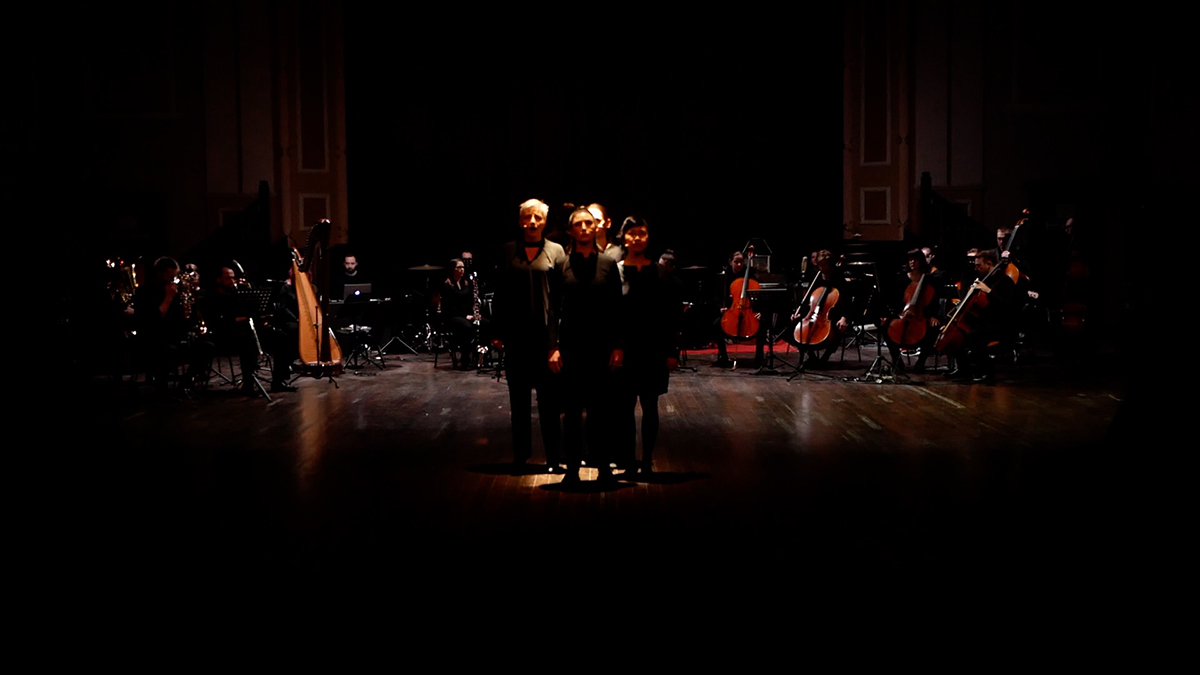
Speechless workshop, photo courtesy Tura New Music
Presenting a work like this involves coordinating and supporting large numbers of performers, crew and venue staff. How important is it to have organisations like Tura New Music and Vitalstatistix to provide a platform for public workshopping?
I was very fortunate to have them partner this workshop period. As you probably know, most operas come to life with the composer holing up and writing the work, then the performance being locked in after with a very short rehearsal period. In this case, we were fortunate to have just under two weeks to try things. I only had the full orchestra for four rehearsals, but I was able to work with the choir, the soloists and the orchestral leaders — Tristen Parr, strings; Aviva Endean, winds; Tina Havelock Stevens, percussion; and Stuart James, electronics and everything else — leading up to and in between the big rehearsals. This was important as it gave everyone time to process what for many was pretty out there new material and a different way of working. The Vitalstatistix venue was perfect for this; they made us feel very welcome, and Tura kept everything running smoothly. I am very pleased with the way it worked out, and can’t wait to see and hear a fully staged production.
–
Speechless, composer, director Cat Hope, for Australian Bass Orchestra, choir, vocal soloists, producer Tura New Music, development partner Vitalstatistix, 2017 Incubator Residency Program.
Top image credit: Cat Hope and Susan Studham (stage manager) at production desk, Speechless workshop, photo Deborah May
A brilliant white five-stepped amphitheatre dominates an otherwise deeply dark performance space, the orchestra suspended immediately behind and above. If Britten’s The Rape of Lucretia is a curious melding of Greek Tragedy and mediaeval Catholic morality play, this set inclines to the former but also evokes a space for debate, a symposium in which tensions between pagan and Christian values play out as we attend to the dictums of the opera’s two Christian narrators while witnessing ever evolving psychological tensions.
Sydney Chamber Opera tackles head-on the long acknowledged infelicities of Britten’s opera, an inherent sexism compounded by its Christian narrational framework and a much-debated ambiguity: is the Roman Lucretia raped or seduced by Tarquinius, son of the city’s despotic Etruscan ruler? Directors Kip Williams and Elizabeth Gadsby leave us in no doubt about the latter and overtly subvert the work’s sexism.
Conductor Jack Symonds, singers and chamber ensemble reveal the full range and heft of Britten’s score — gloriously intimate, seductive, martial, probing, emotionally nuanced and grandly impassioned. Authoritatively played and sung, it’s a sublimely cogent listening experience, one that provides a firm foundation for a challenging directorial response to the opera.
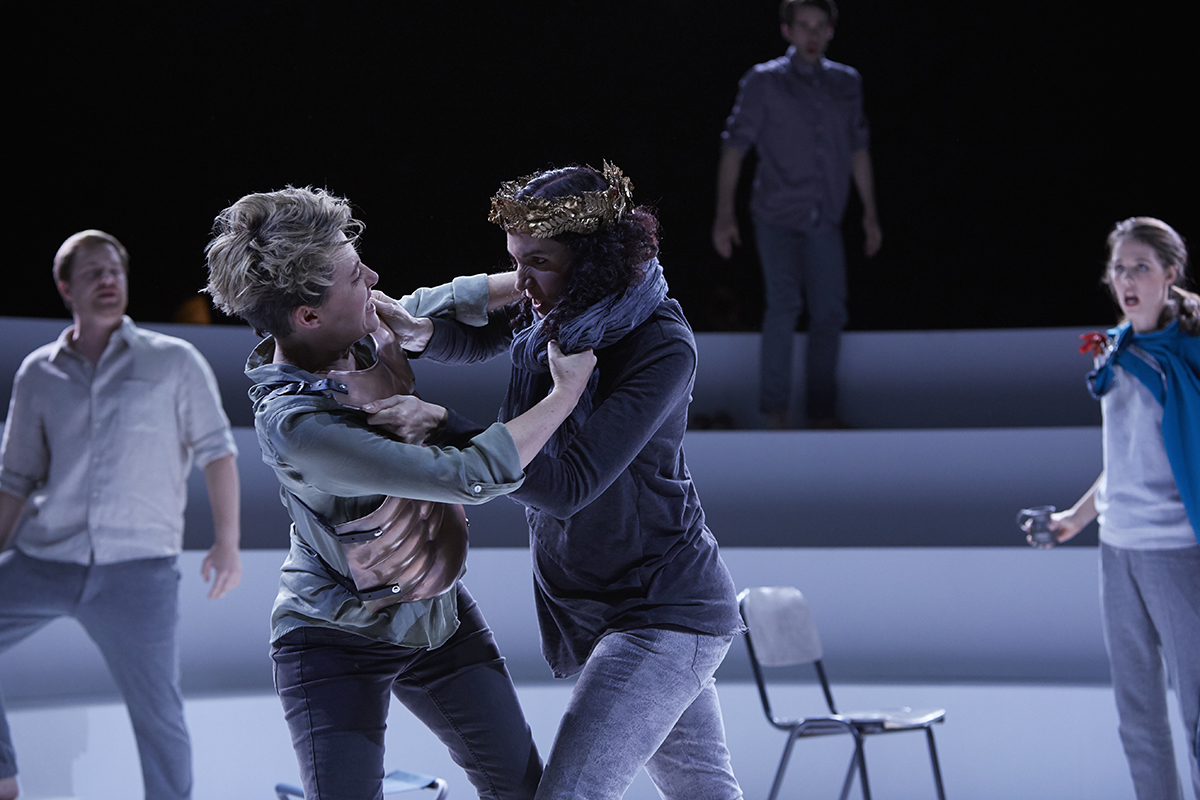
L-R Nathan Lay, Jane Sheldon, Jessica O’Donoghue, Jeremy Kleeman, Anna Dowsley, in The Rape of Lucretia, Sydney Chamber Opera, Carriageworks 2017, photo Zan Wimberley
The company’s well-publicised solution to the work’s problems entails a kind of gender role reversal to heighten, for example, our sense of the brutality of the male characters’ drunken sexism. Three casually modern-dressed female performers, lightly attired with props (a crown, a cloak, a breastplate) play the male characters, lip-synching the singers of their roles, who largely hover nearby and sometimes move in parallel with their actors, individually or in carefully choreographed clusters across the amphitheatre.
The men likewise perform the female roles, albeit in relatively elaborate costumes which make much more, possibly too much, of the gender swap, turning gesture into transformation. At its best the device works as intended, underlining the binary absolutes that drive the tragedy and delivering a Brechtian distanciation. There are moments of affecting mime with male bodies expressing heightened vulnerability.
At other times, it’s distracting, the focus on the lip-synching actor lost amid stage movement and variable light levels. At its most potent, largely later in the production, actors’ and singers’ bodies become so closely entwined that there’s an almost Bunraku effect, in which the actors become avatars for their singer-characters or, most affectingly, a melding of genders, for example in the staging of Tarquinius’ assault, the singer Lucretia is as much threatened as the man who is playing her. Finally, the device disappears, giving each key character sole possession of body and voice to bring home the full power of the opera’s closing stages.
The splitting of body and voice makes it difficult for a performer to consistently develop character, especially Lucretia, whose response to Tarquinius and subsequent suicide (a rather literally staged account of the wrenching “Blood washes my shame away”) require a clear emotional through-line. There’s no doubting the acting of the lip-synchers, like Jessica O’Donoghue’s haughty, prowling, sword-wielding Tarquinius or Jeremy Kleeman’s distraught Lucretia, but the discontinuity between the latter and Anna Dowsley’s sung Lucretia when the soprano fully takes the stage is telling, undercutting the full weight of the tragedy. We know the voice, but not the body as Lucretia. The execution of the device is at times brilliantly realised but its effect is only partly revelatory.
The handling of the Male and Female Chorus by the directors implicates them deeply in the drama; they’re not the physically detached commentators Britten insisted on. They move among the other characters, paying not only close attention but sometimes becoming third partners in the physical pairing of the singers and their actors and, if not acknowledged by the others, sharing in the evolving tragedy. But they diverge, the Female Chorus spatially aligning herself with Lucretia, while the Male Chorus, in the production’s boldest stroke, transforms into a mitre-crowned priest conducting a mass, bathed in red light and dominating the amphitheatre.
This directorial strategy corresponds with and underlines the Female Chorus’ potential loss of faith when she sings “Is it all? Is all this suffering in vain?” with passionately existential plangency and conjuring images of ocean, desert and wilderness, in contrast with the Male Chorus’ predictable re-assurance, a blanket hope offered from a position of power but unable to reveal what Christ’s sacrifice and God’s forgiveness have to precisely say about Lucretia’s fate.
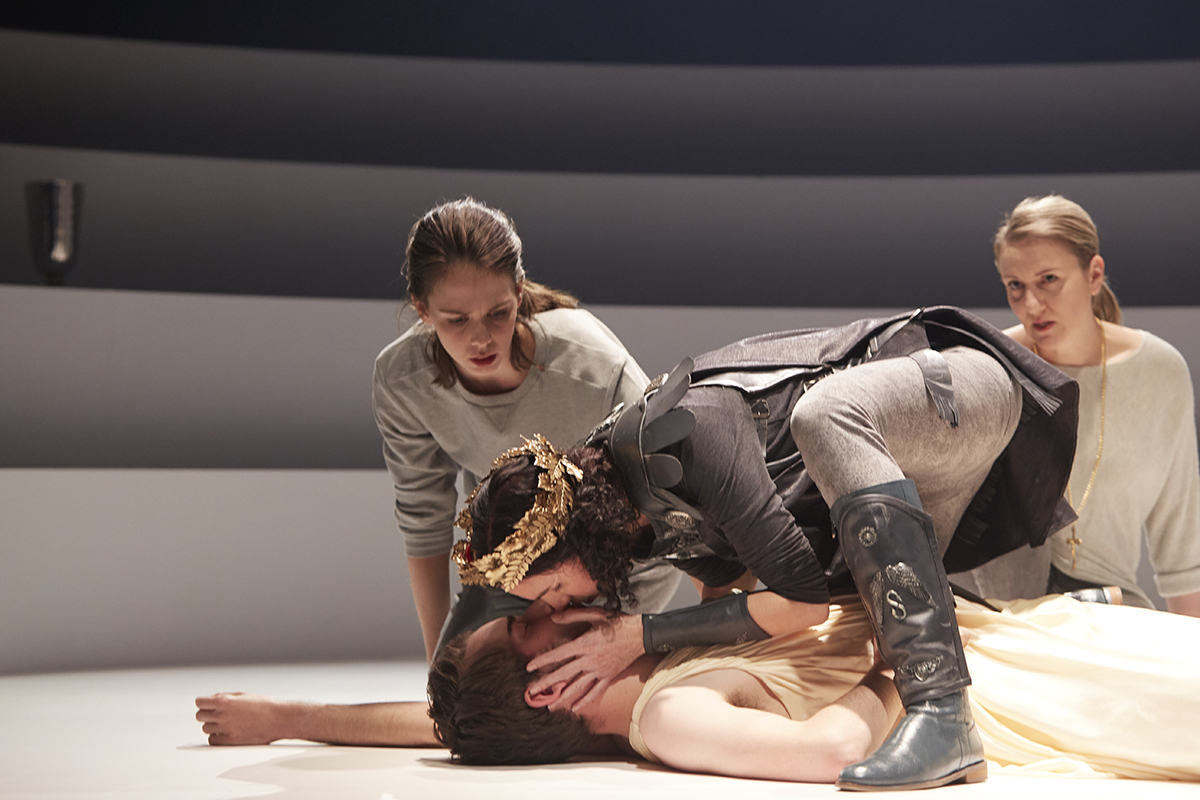
L-R Anna Dowsley, Jeremy Kleeman, Jessica O’Donoghue, Celeste Lazarenko in The Rape of Lucretia, Sydney Chamber Opera, Carriageworks 2017, photo Zan Wimberley
Prior to the Female Chorus’ expression of loss, the Romans’ collective shock and grief is expressed with great power by singers and orchestra in the complex weave of the work’s penultimate song, “This dead hand lets fall,” framed by Christian ceremony and the white amphitheatre awash with blood. Their demanding “Is this it all?” declines into a softly resigned “This is all…” which prompts the Female Chorus’ retort, “Is it all?” This is a formidable challenge, which Jack Symonds believes musically represents Britten’s position and which the directors have made visually explicit, countering the Male Chorus’ calm answer, “This is not all” and “He is all,” with an image of all-encompassing Christianity. Within this sits Lucretia, to whom the Female Chorus, refusing to wear the church’s purple, slowly reaches out, dangling her small golden crucifix as if about to drop or, less likely, offer it. It’s an affecting and bold take on Britten’s vision.
By strikingly foregrounding The Rape of Lucretia’s contradictions and inventively resolving them within the logic of the production, largely non-naturalistically but for the most part without loss of feeling, Sydney Chamber Opera has produced a challenging account of the work. Its strength lies in its ensemble playing, musically and theatrically, with singers skilfully responding to the acting demands of non-stereotypical characterisations, lip-synching and complex blocking. Damien Cooper’s subtly graded lighting of David Fleischer’s embracing set amplifies the production’s pyschological nuancing. Jack Symonds believes Britten’s opera more than stands alongside its grand peers. Certainly this production, while in the end veering towards hyperbole, grants the opera an unexpected sense of scale if forgoing organic character evolution, not least for Lucretia.
Anna Dowsley’s singing nevertheless provided lucid aural continuity, from the liquid beauty of “Flowers bring to every year….” (woven with solo oboe) and the near mad fierceness of “Give him this orchid” to the horrified sense of almost numb suspension in lines that poignantly hover between song and speech in “Last night Tarquinius ravished me.” Sydney Chamber Opera’s The Rape of Lucretia is a memorable provocation, made by collaborators determined to free the opera’s greatness of its formal and cultural limitations, quite a task, but an admirable attempt in which the work’s raw power and fine subtleties were frequently felt.
–
Sydney Chamber Opera with Victorian Opera, The Rape of Lucretia, composer Benjamin Britten, musical director Jack Symonds, director Kip Williams, co-director, costume designer Elizabeth Gadsby, performers Anna Dowsley, Nathan Lay, Celeste Lazarenko, Andrew Goodwin, Jeremy Kleeman, Simon Lobelson, Jane Sheldon, Jessica O’Donoghue, set design David Fleischer, lighting design, Damien Cooper; Carriageworks, Sydney, 19, 21, 22, 24, 25, 26 Aug
Top image credit: Jane Sheldon, Jessica O’Donoghue, Nathan Lay and Anna Dowsley in The Rape of Lucretia, Sydney Chamber Opera, Carriageworks 2017, photo Zan Wimberley



